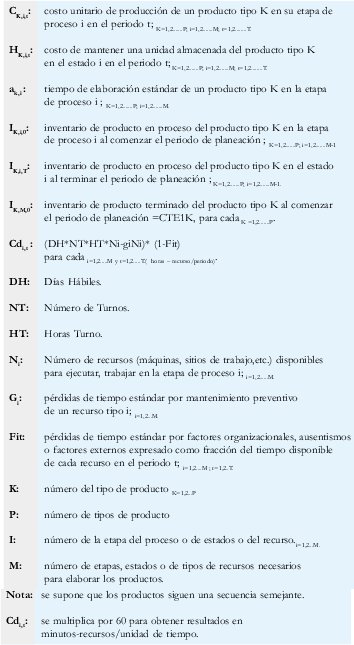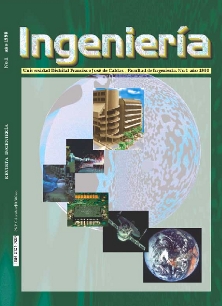DOI:
https://doi.org/10.14483/23448393.2752Published:
1997-11-30Issue:
No 1 (1998)Section:
Research and scienceTécnicas de Planeación Agregada
Downloads
References
Johnson, Lynwood A., and Douglas C. Montgomery, Operations Research in Production Planning, Scheduling and Inventory Control. New York: John Wiley & Sons., 1974.
Bowman, Edward H., «Production Scheduling by the Transportation Method of Linear Programming» Operations Research, 3, No. 1, 1956.
Hanssmann, Fred, Operations Research in Production and Inventory Systems: Planning and Control. New York: John Wiley & Sons, Inc., 1962.
Holt, Charles C., J. Franco Modigliani, John F. Muth, and Herbert A. Simon, Planning Production, Inventories, and Workforce. Englewood Cliffs, NJ: Prentice Hall, 1960.
Buffa, Elwood, and J. G. Miller, Production Inventor y Systems: Planning and Control. Homewood, IL: Richard d. Irwin, 1979.
Ravindra K. Ahuja, Thomas L. Magnanti and James B. Orlin, Network Flows, Englewood Cliffs, New Jersey :Prentice Hall, 1993.
Edward A. Silver, Decision Sistems for Inventory Management and Production Planning. New York: John Wiley & Sons. Second Edition, 1985.
David J. Sumanth, Ingeniería y Administración de la Productividad, México: Mc GRAW-HILL, 1990.
Roger G. Schroeder, Administración de Operaciones, México: Mc GRAW-HILL, Tercera Edición, 1992.
Kenneth D. Lawrence and Stelios H. Zanakis, Models and Methods of Production Planning and scheduling, U.S.A., 1984 by the Institute of In dustrial Engineers.
Bedworth, Sistemas Integrados de Producción, Editorial Limusa, México, Segunda edición, 1994.
Hamdy Taha, Investigación de Operaciones, México, Editorial Alfaomega, Segunda Edición 1991.
How to Cite
APA
ACM
ACS
ABNT
Chicago
Harvard
IEEE
MLA
Turabian
Vancouver
Download Citation
Investigación y Ciencia
Ingeniería, 1998-00-00 nro:1 pág:28-30
Técnicas de planeación agregada
César A. López B.
Profesor Facultad de Ingeniería, Universidad Distrital Francisco José de Caldas
INTRODUCCIÓN
Para la solución de problemas relacionados con la planeación agregada dependiendo de su naturaleza es posible utilizar técnicas basados en un proceso de ensayo y error, sistema de expertos basados en el conocimiento, simulación, heurísticas y la utilización de modelos matemáticos abstractos.
Partiendo del conocimiento de los sistemas, la estructura del modelo matemático y el conocimiento de las técnicas y de las herramientas disponibles para su tratamiento, se selecciona la técnica adecuada por parte de quienes formulan el plan agregado. Con el propósito de mostrar una metodología para la solución de un problema de planeación agregada se presenta a consideración el modelo siguiente:
MODELO MULTIPRODUCTO CON RESTRICCIONES DE CAPACIDAD, MULTIETAPAS SIN ESCASEZ
Objetivo:
Minimizar costos de un plan agregado de producción
Función Objetivo:
F=f(Xk,i,t ; Ik,i,t ;k=1,2,...,P ;i=1,2,...,M ;t=1,2,...,T)= Función costo de planeación agregada.
Variables de decisión:
XK,i,t: Cantidad a producir del producto tipo K, en la etapa de proceso i, en el periodo t; K=1,2.......P; i=1,2.......M; t=1,2........T.
IK,
ikit: Inventario del producto tipo K en un estado i al finalizar el periodo t;
K=1,2.......P; i=1,2.......M; t=1,2........T.
Variables de estado:
Dk,t: Demanda del producto terminado tipo K al finalizar el período t;k=1,2.....P y t=1,2.....T.
Cdi,t: Capacidad disponible del recurso tipo i que se utiliza en la etapa de proceso i en el periodo t;i=1,2.....M y t=1,2.....T.
Parámetros:

Formulación1:

REFERENCIAS
[1] Johnson, Lynwood A., and Douglas C. Montgomery, Operations Research in Production Planning, Scheduling and Inventory Control. New York: John Wiley & Sons., 1974.
[2] Bowman, Edward H., «Production Scheduling by the Transportation Method of Linear Programming» Operations Research, 3, No. 1, 1956.
[3] Hanssmann, Fred, Operations Research in Production and Inventory Systems: Planning and Control. New York: John Wiley & Sons, Inc., 1962.
[4] Holt, Charles C., J. Franco Modigliani, John F. Muth, and Herbert A. Simon, Planning Production, Inventories, and Workforce. Englewood Cliffs, NJ: Prentice Hall, 1960.
[5] Buffa, Elwood, and J. G. Miller, Production Inventor y Systems: Planning and Control. Homewood, IL: Richard d. Irwin, 1979.
[6] Ravindra K. Ahuja, Thomas L. Magnanti and James B. Orlin, Network Flows, Englewood Cliffs, New Jersey :Prentice Hall, 1993.
[7] Edward A. Silver, Decision Sistems for Inventory Management and Production Planning. New York: John Wiley & Sons. Second Edition, 1985.
[8] David J. Sumanth, Ingeniería y Administración de la Productividad, México: Mc GRAW-HILL,1990.
[9] Roger G. Schroeder, Administración de Operaciones, México: Mc GRAW-HILL, Tercera Edición, 1992.
[10] Kenneth D. Lawrence and Stelios H. Zanakis, Models and Methods of Production Planning and scheduling, U.S.A., 1984 by the Institute of Industrial Engineers.
[11] Bedworth, Sistemas Integrados de Producción, Editorial Limusa, México, Segunda edición,1994.
[12] Hamdy Taha, Investigación de Operaciones, México, Editorial Alfaomega, Segunda Edición 1991.
NOTAS
1. El cálculo de las capacidades se referencia en el texto Aplicaciones computacionales en producción. Dusko Kalenatic y Luis Ernesto Blanco R. Fondo Editorial Biblioteca de catedráticos Universidad Distrital.1993.
Creation date:
License
From the edition of the V23N3 of year 2018 forward, the Creative Commons License "Attribution-Non-Commercial - No Derivative Works " is changed to the following:
Attribution - Non-Commercial - Share the same: this license allows others to distribute, remix, retouch, and create from your work in a non-commercial way, as long as they give you credit and license their new creations under the same conditions.





2.jpg)










